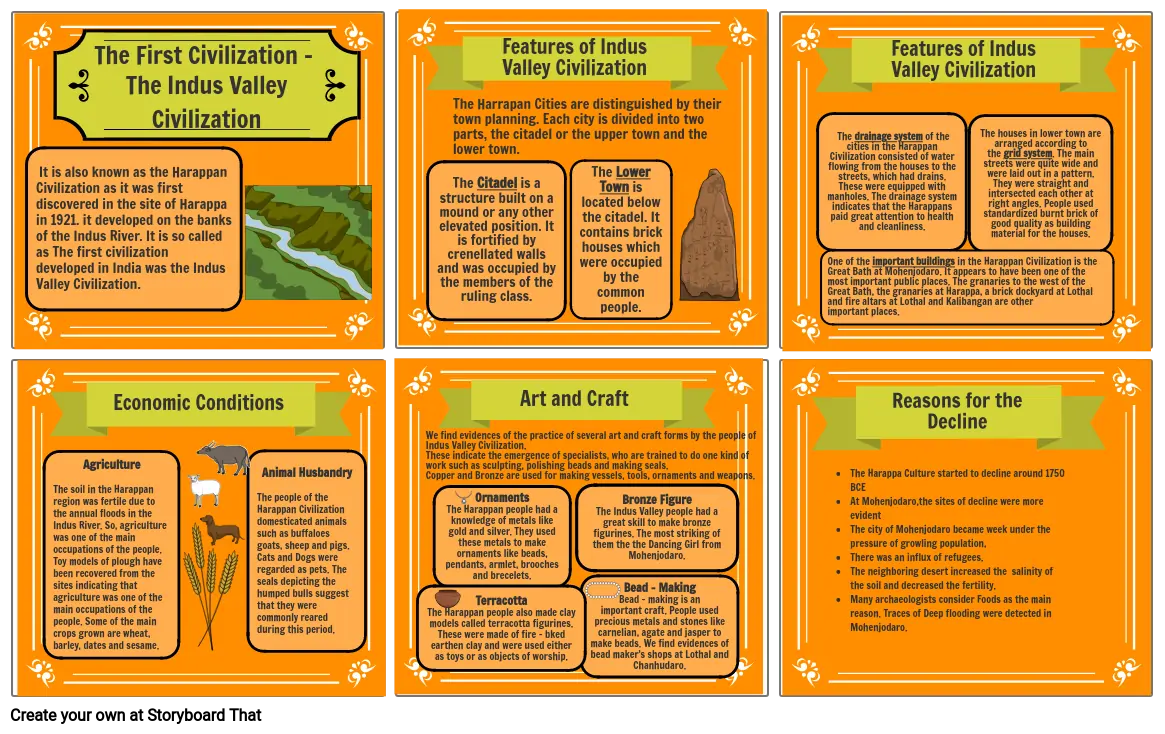Multiple Assessment - The First Civilization

Storyboard Text
- It is also known as the Harappan Civilization as it was first discovered in the site of Harappa in 1921. it developed on the banks of the Indus River. It is so called as The first civilization developed in India was the Indus Valley Civilization.
- The First Civilization - The Indus Valley Civilization
-
- Features of Indus Valley Civilization
- The Citadel is a structure built on a mound or any other elevated position. It is fortified by crenellated walls and was occupied by the members of the ruling class.
- The Harrapan Cities are distinguished by their town planning. Each city is divided into two parts, the citadel or the upper town and the lower town.
- The Lower Town is located below the citadel. It contains brick houses which were occupied by the common people.
- Features of Indus Valley Civilization
- The drainage system of the cities in the Harappan Civilization consisted of water flowing from the houses to the streets, which had drains. These were equipped with manholes. The drainage system indicates that the Harappans paid great attention to health and cleanliness.
- One of the important buildings in the Harappan Civilization is the Great Bath at Mohenjodaro. It appears to have been one of the most important public places. The granaries to the west of the Great Bath, the granaries at Harappa, a brick dockyard at Lothal and fire altars at Lothal and Kalibangan are other important places.
- The houses in lower town are arranged according to the grid system. The main streets were quite wide and were laid out in a pattern. They were straight and intersected each other at right angles. People used standardized burnt brick of good quality as building material for the houses.
- AgricultureThe soil in the Harappan region was fertile due to the annual floods in the Indus River. So, agriculture was one of the main occupations of the people. Toy models of plough have been recovered from the sites indicating that agriculture was one of the main occupations of the people. Some of the main crops grown are wheat, barley, dates and sesame.
- Economic Conditions
- Animal HusbandryThe people of the Harappan Civilization domesticated animals such as buffaloes goats, sheep and pigs. Cats and Dogs were regarded as pets. The seals depicting the humped bulls suggest that they were commonly reared during this period.
- TerracottaThe Harappan people also made clay models called terracotta figurines. These were made of fire - bked earthen clay and were used either as toys or as objects of worship.
- We find evidences of the practice of several art and craft forms by the people of Indus Valley Civilization.These indicate the emergence of specialists, who are trained to do one kind of work such as sculpting, polishing beads and making seals.Copper and Bronze are used for making vessels, tools, ornaments and weapons.
- OrnamentsThe Harappan people had a knowledge of metals like gold and silver. They used these metals to make ornaments like beads, pendants, armlet, brooches and brecelets.
- Art and Craft
- Bronze FigureThe Indus Valley people had a great skill to make bronze figurines. The most striking of them the the Dancing Girl from Mohenjodaro.
- Bead - MakingBead - making is an important craft. People used precious metals and stones like carnelian, agate and jasper to make beads. We find evidences of bead maker's shops at Lothal and Chanhudaro.
- The Harappa Culture started to decline around 1750 BCEAt Mohenjodaro,the sites of decline were more evidentThe city of Mohenjodaro became week under the pressure of growling population,There was an influx of refugees.The neighboring desert increased the salinity of the soil and decreased the fertility.Many archaeologists consider Foods as the main reason. Traces of Deep flooding were detected in Mohenjodaro.
- Reasons for the Decline
Over 30 Million Storyboards Created

